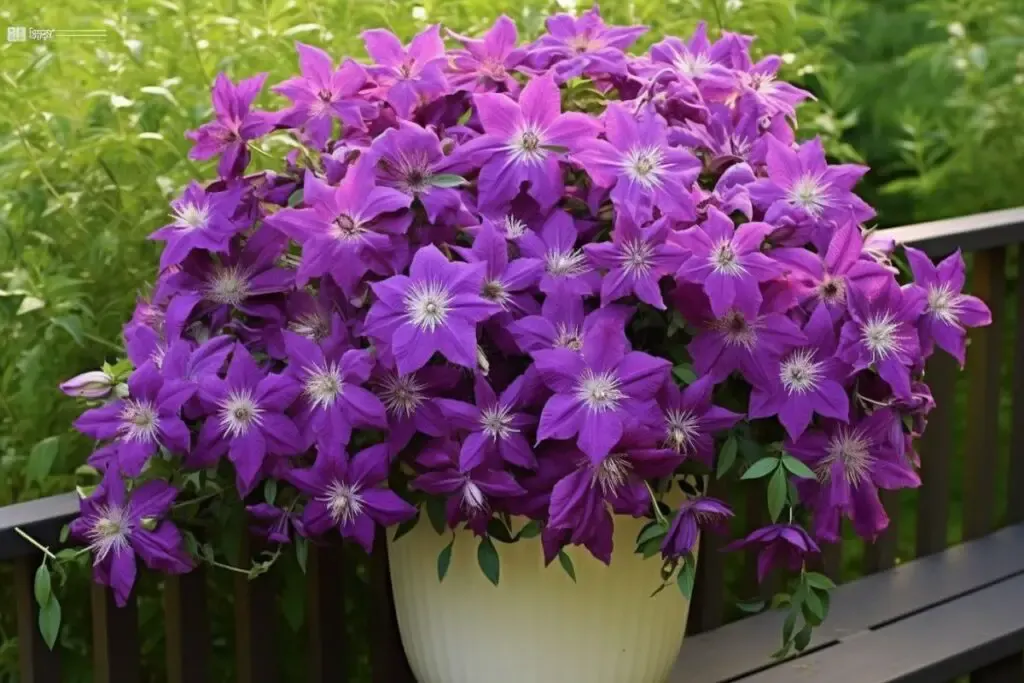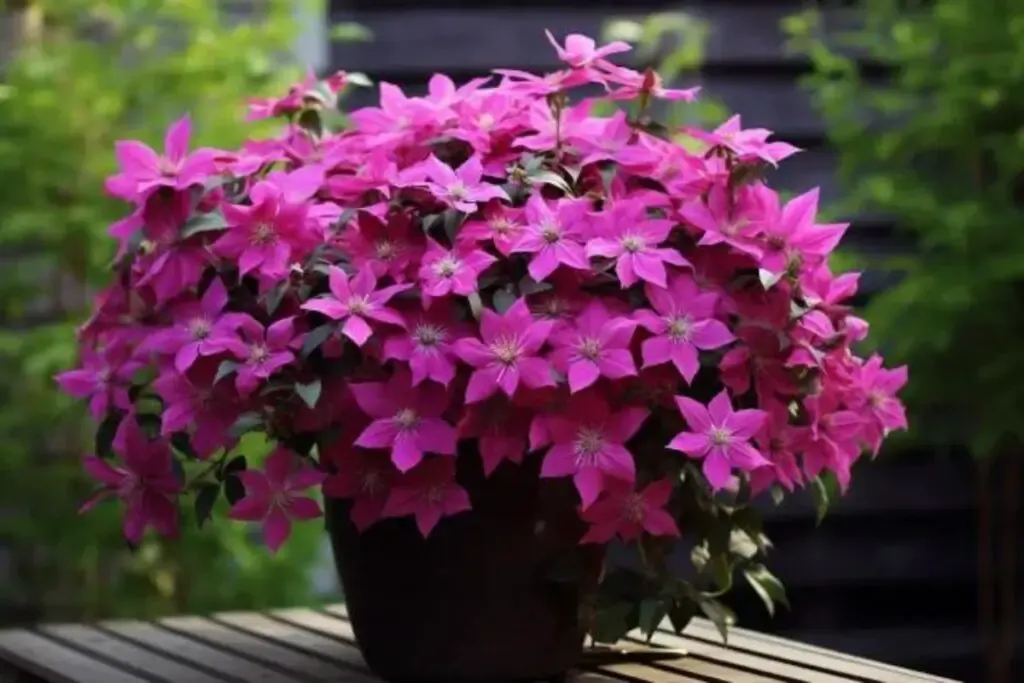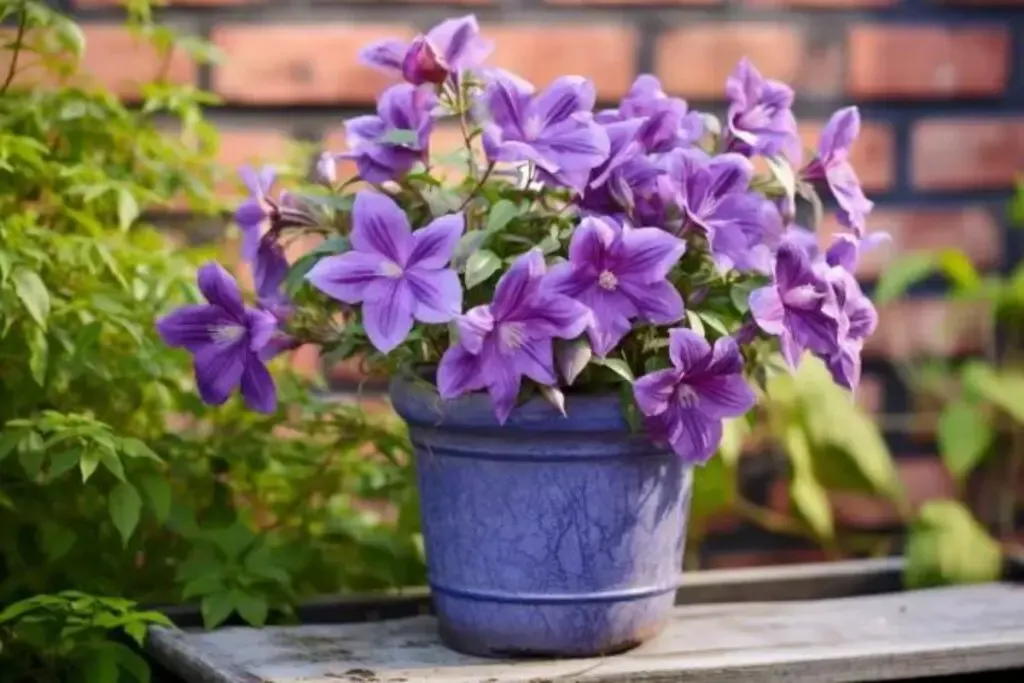Clematis vines are the secret magicians of the potted plant world, transforming even the smallest of patios into enchanting, bloom-filled retreats. If you’ve long admired the cascading beauty of these plants but thought they were too challenging to grow in containers, prepare to have your world pleasantly turned upside down.
As an expert gardening blogger with a passion for turning the improbable into the possible, I’ll guide you through mastering the art of growing clematis in pots.
Let’s cultivate not just plants, but confidence!
Does Clematis Grow Well in Pots?
The answer, resoundingly, is yes! Clematis, with their climbing tendrils and vibrant flowers, are remarkably well-suited to life in pots. This may come as a surprise to those who’ve seen these plants scale the heights of garden trellises and walls, but clematis’s adaptability is one of their most delightful traits.
In pots, clematis roots are protected from the competitive sprawl of other garden plants, and with adequate attention to soil quality, watering, and feeding, these vining beauties will thrive.
Pot cultivation also allows for easy manipulation of the plant’s growing conditions, letting you whisk your clematis into the sun or shade as needed. It’s like giving your plant a VIP pass to the best spots on your patio or balcony.
Growing clematis in pots does require some adjustment. A large, deep container is non-negotiable, as is a commitment to regular watering and fertilization. But the reward of lush, vertical blooms that turn a simple pot into a pillar of petals is worth every bit of effort.
Best Clematis Varieties for Pots
Not all clematis are created equal when it comes to pot cultivation. The best varieties for your container garden are those that adapt to a more compact root system and still reward you with their characteristic prolific blooms.
1. Clematis ‘Bijou’

Imagine a waterfall of mauve blossoms tumbling over the edge of a hanging basket, and you’ve pictured ‘Bijou’. This variety is a gem, as its name suggests, with a penchant for spreading horizontally rather than reaching for the stars.
‘Bijou’ offers the perfect solution for gardeners who crave the elegance of clematis without the height, making it an ideal companion for your coziest outdoor nooks.
2. Clematis ‘Picardy’

For those who prefer their flowers with a touch of drama, ‘Picardy’ stands out with its velvety purple petals, each accented with a bright pink stripe.
Its compact nature doesn’t detract from its show-stopping blossoms, which appear generously throughout the summer. ‘Picardy’ is tailor-made for pots, bringing a slice of theatrical flair to your container gardening.
3. Clematis ‘Parisienne’

With ‘Parisienne’, you get an abundance of large, showy flowers on a plant that’s been bred specifically with container living in mind. Its soft lavender blooms, often with a hint of pink at the center, present a delicate contrast to its robust green foliage.
This variety has a more upright habit, making it a great choice for adding vertical interest to your space.
How to Grow and Care For Clematis in Pots
Growing clematis in pots might seem like a horticultural high-wire act, but it’s really a grounded affair rooted in paying attention to a few key details.
Let’s walk through the essentials of planting and care, ensuring that your potted clematis doesn’t just grow, but thrives.
Planting
When planting clematis in a pot, timing, and technique are your best friends. Spring is an ideal time, to give your plant a full growing season to establish itself.
Begin by soaking the root ball to hydrate it thoroughly, which eases the transition into its new home. Plant the clematis a bit deeper than it sat in its nursery pot; this encourages strong new shoots to grow from the base, creating a fuller plant.
Pot Size
Clematis are deep-rooted plants, and in pots, they require ample space to spread those roots. Choose a pot at least 18 inches deep and equally wide. This size accommodates the root system and allows for stable growth. Remember, a cramped clematis is an unhappy clematis.
Light
Your potted clematis is a bit of a sun worshipper, but it appreciates a good sun hat, so to speak.
Aim for a location that basks in full sun to partial shade, ensuring that the roots and base of the plant are shaded while the top enjoys the sunshine. This duality is key to vibrant blooms and a healthy plant.
Soil
Think of soil as the clematis’s favorite meal—a feast it’ll dine on every day. The right mix is well-draining, fertile, and holds moisture without becoming waterlogged.
A blend of high-quality potting soil with compost and a handful of perlite or grit for drainage makes for a gourmet soil mix that your clematis will relish.
Water
Effective watering is vital for potted clematis. They require consistent moisture, but overwatering can lead to issues like root rot.
Check the top inch of soil; if it’s dry, it’s time to water. In hot weather, daily watering might be necessary but always ensure good drainage. Striking a balance between keeping the soil moist and avoiding waterlogging is key to nurturing your clematis.
Regular, mindful watering encourages robust growth and beautiful blooms.
Temperature and Humidity
Clematis in pots thrive in moderate climates, preferring warm days and cooler nights. Protect them from extreme heat by providing afternoon shade.
In drier regions, occasional misting helps maintain adequate humidity. During cold winters, insulate the pot or move it to a sheltered area, as potted clematis are more susceptible to freezing temperatures. Regular monitoring and slight adjustments ensure a healthy, flourishing plant.
Fertilizer
Fertilizing your potted clematis is key to promoting vigorous growth and stunning blooms. Use a balanced, slow-release fertilizer in early spring to kick-start the growing season. Then, switch to a liquid fertilizer every two weeks during the growing period for continuous nourishment.
Be cautious not to over-fertilize, as this can lead to more foliage and fewer flowers. Lastly, remember to follow the manufacturer’s instructions for the best results.
Pruning Potted Clematis
Pruning can seem like a complex dance, but once you learn the steps, it’s a simple routine that keeps your clematis in rhythm.
These plants fall into three pruning categories: Group 1 blooms on old wood and requires little to no pruning, Group 2 benefits from light pruning to encourage a robust display, and Group 3 thrives with more aggressive cuts.
For potted clematis, particularly Group 2 or 3, a yearly prune can help manage size and encourage healthy growth. In late winter or early spring, before active growth begins, trim Group 2 varieties to shape and remove any dead or weak stems.
For Group 3, you’ll want to cut back the stems to about a foot high to ensure vigorous growth and flowering. Remember, the goal is to stimulate the clematis to produce as many blooms as possible without the plant becoming a tangled mess.
Overwintering
Overwintering clematis in pots is a bit like tucking in a child on a cold night. These plants may seem tough, but they appreciate some extra care when the temperatures drop.
If you’re in a region where winters are harsh, consider moving your potted clematis to a sheltered spot, like against the house, or even into an unheated garage or shed where it’s cool but frost-free.
For added insulation, wrap the pot with bubble wrap or burlap. This helps prevent the soil from freezing completely, which can damage the roots. Also, be mindful of watering; the plant needs less moisture during dormancy, but the soil should not be allowed to dry out entirely.
With the right pruning and overwintering care, your potted clematis will not just survive but will return year after year with the vigor and beauty of a perennial favorite in your container garden.

